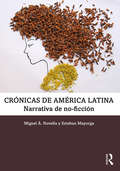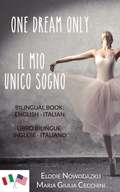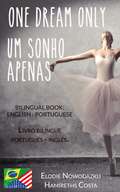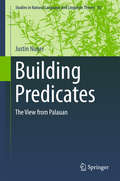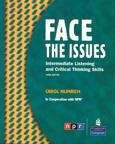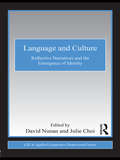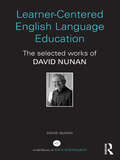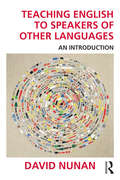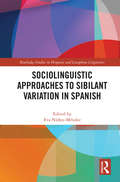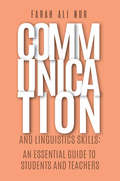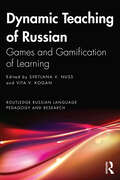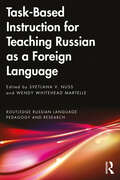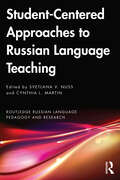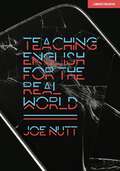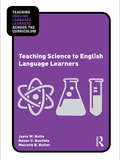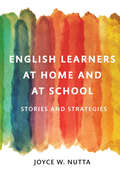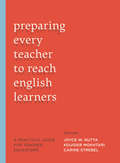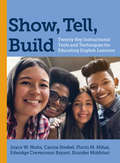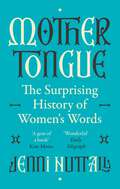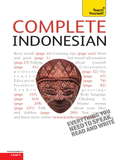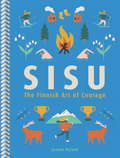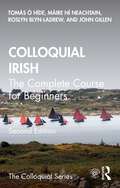- Table View
- List View
Crónicas de América Latina: Narrativa de no-ficción
by Miguel Á. Novella Esteban MayorgaCrónicas de América Latina: narrativa de no-ficción es la primera edición de una novedosa antología de crónicas diseñada para la enseñanza de español avanzado. Los textos, fascinantes y accesibles, permiten que los estudiantes se adentren en la compleja realidad contemporánea, tanto política como social y cultural, de América Latina, mientras refuerzan la lectura, la redacción y la conversación. Los ejercicios, todos ellos diseñados a partir de los propios textos, pretenden repasar problemas gramaticales y léxicos tradicionales, con especial énfasis en aquellos que atañen a las variedades dialectales del español americano: por ejemplo, el uso del pronombre ‘vos’. Este libro es un excelente material de lectura que puede usarse en clases de español como segunda lengua o en clases de español para hablantes de herencia, tanto en clases de lengua (gramática o conversación) como de contenido (cultura). Dividido en nueve capítulos, el material abarca temas cruciales tales como política, identidad, raza, género, inmigración, violencia, exilio, medio ambiente, gastronomía, fútbol y música. Cada texto puede leerse de forma independiente, lo que permite que los profesores seleccionen las lecturas según las particularidades de cada curso. Pensado en un principio para estudiantes de español, esta antología es sobre todo una lectura indispensable para cualquier persona interesada en la zona que concentra el mayor número de hispanohablantes en el mundo.
One Dream Only/Il mio unico sogno (Libro bilingue: inglese/italiano)
by Elodie Nowodazkij Maria Giulia CecchiniStai imparando l'inglese? Are you learning Italian? This book can help you with that: one page in English, one page in Italian ... Questo libro può aiutarti: una pagina è in inglese e una in italiano. She thought she was on her way to the top... Sixteen-year-old Natalya Pushkaya has one dream and one dream only: becoming the best ballerina ever. Dancing's always been who she is and she's working her hardest to land the main role of the School of Performing Arts' end-of-the-year showcase. But...will she make it? Within a week, Natalya's life will be changed forever. Credeva di essere sulla strada per il successo... La sedicenne Natalya Pushkaya ha un solo e unico sogno: diventare la più grande ballerina di sempre. La danza è sempre stata parte di lei, e ce la metterà tutta per ottenere il ruolo principale nello spettacolo di fine anno alla scuola di Discipline dello Spettacolo Ma... ci riuscirà? Nel giro di una settimana, la vita di Natalya cambierà per sempre.
Um Sonho Apenas/One Dream Only (Livro bilíngue: Português - Inglês)
by Elodie Nowodazkij Hamíreths CostaEstá aprendendo inglês? Are you learning Portuguese? This book can help you with that: one page in English, one page in Portuguese... Este livro pode te ajudar: uma página em inglês e outra em português... She thought she was on her way to the top... Sixteen-year-old Natalya Pushkaya has one dream and one dream only: becoming the best ballerina ever.Dancing's always been who she is and she's working her hardest to land the main role of the School of Performing Arts' end-of-the-year showcase. But...will she make it? Within a week, Natalya's life will be changed forever. ------------------------------------- Ela achava que estava a caminho do topo... Natalya Pushkaya de 17 anos tem um sonho apenas: se tornar a melhor bailarina do mundo. Dançar sempre foi o que ela é e ela está trabalhando duro para conseguir o papel principal no show de final de ano da Escola de Artes Cênicas. Mas ela vai conseguir? Em uma semana a vida de Natalya vai mudar para sempre.
Building Predicates: The View from Palauan (Studies in Natural Language and Linguistic Theory #92)
by Justin NugerThis volume provides a comprehensive analysis of the syntax of Palauan that will appeal to anyone interested in Austronesian languages or formal syntactic and morphological theory. This volume proposes that words in Palauan are not drawn directly from a mental lexicon, but are instead composed at least partially in the syntax. Using original data from syntactic constructions not previously explored in the language, the author entertains several competing theories of word formation and highlights the compatible and incompatible aspects of each, through an exploration into new corners of Palauan syntax and morphology.
Face The Issues: Intermediate Listening And Critical Thinking Skills
by Carol Numrich National Public Radio (U.S.) StaffFace the Issues: Intermediate Listening and Critical Thinking Skills, Third Edition, by Carol Numrich, in cooperation with NPR®, helps intermediate students develop critical thinking skills as they gain insight into American attitudes and values. Each thought-provoking unit is based on an authentic radio broadcast from National Public Radio®. Students develop essential listening strategies such as predicting, looking at language, understanding main ideas and points of view, and focusing on details. Language and concepts are integrated through follow-up critical thinking activities including discussion, debate, values clarification, survey, role play, case study, inteview, and simulation.
Language and Culture: Reflective Narratives and the Emergence of Identity (ESL & Applied Linguistics Professional Series)
by David NunanThis state-of-the-art exploration of language, culture, and identity is orchestrated through prominent scholars’ and teachers’ narratives, each weaving together three elements: a personal account based on one or more memorable or critical incidents that occurred in the course of learning or using a second or foreign language; an interpretation of the incidents highlighting their impact in terms of culture, identity, and language; the connections between the experiences and observations of the author and existing literature on language, culture and identity. What makes this book stand out is the way in which authors meld traditional ‘academic’ approaches to inquiry with their own personalized voices. This opens a window on different ways of viewing and doing research in Applied Linguistics and TESOL. What gives the book its power is the compelling nature of the narratives themselves. Telling stories is a fundamental way of representing and making sense of the human condition. These stories unpack, in an accessible but rigorous fashion, complex socio-cultural constructs of culture, identity, the self and other, and reflexivity, and offer a way into these constructs for teachers, teachers in preparation and neophyte researchers. Contributors from around the world give the book broad and international appeal.
Learner-Centered English Language Education: The Selected Works of David Nunan
by David NunanThis carefully crafted collection provides a snapshot of the evolution of David Nunan‘s theoretical and empirical contributions to the field of second language education over the last 40 years. The volume focuses on the development of his work on second language curricula, and in particular, the work for which he is best known: learner-centered education and task-based learning and teaching. David Nunan has been a language teacher, researcher and consultant for 40 years. He has lived and worked in many countries, principally in the Asia-Pacific region, but also in the Americas, Europe and the Middle-East. In addition to his research and scholarly work, he is the author of several major textbook series for the teaching and learning of English as a foreign Language. These texts are based on his task-based language teaching approach, and are widely used in schools, school systems and universities around the world.
Teaching English to Speakers of Other Languages: An Introduction
by David NunanDavid Nunan's dynamic learner-centered teaching style has informed and inspired countless TESOL educators around the world. In this fresh, straightforward introduction to teaching English to speakers of other languages he presents teaching techniques and procedures along with the underlying theory and principles. Complex theories and research studies are explained in a clear and comprehensible, yet non-trivial, manner without trivializing them. Practical examples of how to develop teaching materials and tasks from sound principles provide rich illustrations of theoretical constructs. The content is presented through a lively variety of different textual genres including classroom vignettes showing language teaching in action, question and answer sessions, and opportunities to 'eavesdrop' on small group discussions among teachers and teachers in preparation. Readers get involved through engaging, interactive pedagogical features and opportunities for reflection and personal application. Each chapter follows the same format so that readers know what to expect as they work through the text. Key terms are defined in a Glossary at the end of the book. David Nunan's own reflections and commentaries throughout enrich the direct, up-close style of the text.
Sociolinguistic Approaches to Sibilant Variation in Spanish (Routledge Studies in Hispanic and Lusophone Linguistics)
by Eva Núñez-MéndezSocial processes and the nature of language variation have driven sibilant variation across the Spanish-speaking world. This book explores the current state of Spanish sibilants and their dialectal variations. Focusing on different processes undergone by sibilants in Spanish (e.g., voicing, devoicing, weakening, aspiration, elision) in various geographical areas and language contact situations, each chapter offers an analysis on a unique sociolinguistic case from different formal, experimental, and data-based approaches. The opening chapter orients the reader with an overview of sibilant system’s evolution, which serves as an anchor to the other chapters and facilitates understanding for readers new to the topic. The volume is organized around three thematic sections: part one, Spain; part two, United States; and part three, Central and South America. The collection includes research on dialects in both Peninsular and Trans-Atlantic Spanish such as Jerezano, Caribbean Spanish in Boston and New York City, Cuban Spanish in Miami, Colombia-Barranquilla Spanish, northern Buenos Aires Argentine Spanish, and USA heritage Spanish, among other case studies. This volume offers an original and concise approach to one of the most studied variables in Spanish phonetics, taking into account geographically-based phonetic variation, sociolinguistic factors, and various Spanish language contact situations. Written in English, this detailed synthesis of the wide-ranging geolinguistic features of Spanish sibilants provides a valuable resource for scholars in Hispanic studies, linguistics, Spanish dialectology and sociolinguistics.
Communication and Linguistics Skills: An Essential Guide To Students And Teachers
by Farah Ali NurCommunication and Linguistics Skills: An Essential Guide to Students and Teachers is a commendably linguistic book of almost 300 pages, and it is a coherent and fascinating work which addresses six topics: * - communication as a discipline of its own * - communication as a language skill * - the eight parts of speech * - linguistics * - word formation and * - the difference between British and American English. It supports language learners with short and clear definitions and exercises of each key linguistic concept in a coherent and easy-to-understand way. It is an invaluable book for students and teachers with other languages as their mother tongue.
Dynamic Teaching of Russian: Games and Gamification of Learning (Routledge Russian Language Pedagogy and Research)
by Svetlana V. Nuss Vita V. KoganDynamic Teaching of Russian: Games and Gamification of Learning explores the theory and practice of gamification in language education with a special focus on Russian, offering an in-depth theoretical account of the psychology of games and their practical application to language teaching. This edited collection brings together diverse perspectives from an international pool of contributors. Topics covered include hands-on game-like activities, play, and games to enrich the Russian language classroom that can be used with both adult and young Russian language learners worldwide. The chapters use case studies to showcase innovative approaches that can be used in the language classroom to both motivate learners and improve the outcomes of teaching Russian. This book will appeal to lecturers, tutors, teachers and all other educators of Russian in subject areas of Russian studies, Slavonic studies, language learning and foreign language acquisition.
Task-Based Instruction for Teaching Russian as a Foreign Language (Routledge Russian Language Pedagogy and Research)
by Svetlana V. Nuss Wendy Whitehead MartelleTask-Based Instruction for Teaching Russian as a Foreign Language presents the most recent developments in the field of task-based language teaching (TBLT) and highlights impactful research-based instructional practices of applying TBLT for the teaching of Russian. This comprehensive volume extends the current understanding of the nature and role of tasks in course development, authenticity in task design, the role of the instructor in TBLT, teaching culture through TBLT, the intersection of complex morphology and explicit grammar instruction with task-based approaches, collaborative interaction within TBLT, and technology-mediated tasks. This resource focuses on the unique set of factors and challenges that arise when applying TBLT in the instruction of Russian and other morphologically rich languages. This edited volume will be of interest to teachers of Russian as well as researchers in Russian language acquisition, language pedagogy, and Slavic applied linguistics.
Student-Centered Approaches to Russian Language Teaching: Insights, Strategies, and Adaptations (Routledge Russian Language Pedagogy and Research)
by Svetlana V. Nuss Cynthia L. MartinStudent-Centered Approaches to Russian Language Teaching looks at how the field of Russian language pedagogy has evolved in recent years due to advances in technology along with shifts in attitudes to language pedagogy, and how the pandemic has compounded and accelerated these changes. This edited collection brings together different perspectives from the field of Russian language pedagogy. With pedagogical conversations now centered around students and their needs, as well as the evolving role of the teacher in the 21st century, this volume highlights the diverse ways in which instructional practices have evolved, making curriculum and assessment more student-centered and Russian language learning more engaging. The collection will be of interest to current and future instructors of Russian as a foreign or additional language who wish to diversify their instruction, as well as students of Russian language pedagogy and second language learning and teaching.
Teaching English for the Real World
by Joe NuttSo much of the teaching in schools of how the English works does not prepare students for the real world. So little has changed in exams, the curriculum, or the way people think about English teaching, in several decades. This book is Joe Nutt's attempt to help schools redress that dramatic imbalance. It's not in any sense a practical teaching guide only for English teachers, nor is it full of hints and tips, lesson plans and schemes of work. Teaching English for the Real World is a far wider consideration of what schools and English teachers should be doing if they wish to prepare secondary school children to be successful and effective users of English, in the real world of work, higher education and adult life they will all too soon enter. If you are an English teacher, by the time you finish reading Teaching English for the Real World, you should be better prepared to deliver lessons that those you teach will forever be grateful for. The book consists of four main sections: English in context, towards the GCSE, choosing texts and technology matters. It starts by putting English clearly into context through a range of current examples. It urges teachers to consider the complex role English usage plays on everything from the side of a bus, through tissue-thin social media, garish slideshows and perky TED talks, to the hundreds of pages of research or official reports so often used as the basis for serious political policy and commercial decision making. It will then examine the classroom status quo and instead of the unrealistic and damaging focus on experiment and creativity, instead of requiring them to write newspaper articles, stories or speeches, the main deliverables in any English GCSE exam, the book will argue that teachers should think carefully about how to connect what children write, with who they are and where they really want to publish. The next section deals with choices of texts. There is a place for children to be taught to write well by example, but there are challenging questions to ask about much of the material routinely chosen. How often are texts and authors selected for study, for reasons that have absolutely nothing whatsoever to do with knowledge or linguistic skill, and everything to do with politics? Even exam boards are guilty of this. The final section examines the relationship between English and the technology real people use to produce it. It reflects on how technology has impacted on the quality of the reading experience itself and argue that there is a crisis in reading in secondary schools, with many children sailing through exams yet leaving school as disinterested and even poor readers. And it suggests how teachers might approach introducing these different risks to children and equip them best to make sound judgements about the way they write and communicate, for personal and employment purposes in adult life.
Teaching English for the Real World
by Joe NuttSo much of the teaching in schools of how the English works does not prepare students for the real world. So little has changed in exams, the curriculum, or the way people think about English teaching, in several decades. This book is Joe Nutt's attempt to help schools redress that dramatic imbalance. It's not in any sense a practical teaching guide only for English teachers, nor is it full of hints and tips, lesson plans and schemes of work. Teaching English for the Real World is a far wider consideration of what schools and English teachers should be doing if they wish to prepare secondary school children to be successful and effective users of English, in the real world of work, higher education and adult life they will all too soon enter. If you are an English teacher, by the time you finish reading Teaching English for the Real World, you should be better prepared to deliver lessons that those you teach will forever be grateful for. The book consists of four main sections: English in context, towards the GCSE, choosing texts and technology matters. It starts by putting English clearly into context through a range of current examples. It urges teachers to consider the complex role English usage plays on everything from the side of a bus, through tissue-thin social media, garish slideshows and perky TED talks, to the hundreds of pages of research or official reports so often used as the basis for serious political policy and commercial decision making. It will then examine the classroom status quo and instead of the unrealistic and damaging focus on experiment and creativity, instead of requiring them to write newspaper articles, stories or speeches, the main deliverables in any English GCSE exam, the book will argue that teachers should think carefully about how to connect what children write, with who they are and where they really want to publish. The next section deals with choices of texts. There is a place for children to be taught to write well by example, but there are challenging questions to ask about much of the material routinely chosen. How often are texts and authors selected for study, for reasons that have absolutely nothing whatsoever to do with knowledge or linguistic skill, and everything to do with politics? Even exam boards are guilty of this. The final section examines the relationship between English and the technology real people use to produce it. It reflects on how technology has impacted on the quality of the reading experience itself and argue that there is a crisis in reading in secondary schools, with many children sailing through exams yet leaving school as disinterested and even poor readers. And it suggests how teachers might approach introducing these different risks to children and equip them best to make sound judgements about the way they write and communicate, for personal and employment purposes in adult life.
Teaching Science to English Language Learners
by Joyce Nutta Nazan U. Bautista Malcolm B. ButlerBooks in the Teaching English Language Learners (ELLs) across the Curriculum Series are written specifically for pre- and in- service teachers who may not have been trained in ELL techniques, but still find themselves facing the realities and challenges of today's diverse classrooms and learners. Each book provides simple and straightforward advice on how to teach ELLs through a given subject area, and how to teach content to ELLs who are at different levels of English language proficiency than the rest of their class. Authored by both language and content area specialists, each volume arms readers with practical, teacher-friendly strategies, and subject-specific techniques. Teaching Science to English Language Learners offers science teachers and teacher educators a straightforward approach for engaging ELLs learning science, offering examples of easy ways to adapt existing lesson plans to be more inclusive. The practical, teacher-friendly strategies and techniques included here are proven effective with ELLs, and many are also effective with all students. The book provides context-specific strategies for the full range of the secondary sciences curriculum, including physical science, life science, earth and space science, science as inquiry, and history and nature of science and more. A fully annotated list of web and print resources completes the book, making this a one volume reference to help science teachers meet the challenges of including all learners in effective instruction. Special features: practical examples of science exercises make applying theory to practice simple when teaching science to ELLs an overview of the National Science Education Standards offers useful guidelines for effective instructional and assessment practices for ELLs in secondary grades graphs, tables, and illustrations provide additional access points to the text in clear, meaningful ways.
English Learners at Home and at School: Stories and Strategies
by Joyce W. NuttaThe engaging profiles of English Learners at Home and at School offer access to a deeper and broader understanding of the lived experiences of English learners and their families. Such knowledge is essential for all educators in order to anticipate the needs of, and best support, English learners.In this highly readable volume, Joyce W. Nutta helps to build the bridge of knowledge and empathy between teachers and the English learners they support. In an inspired approach to the topic, she presents six compelling portraits of English learners who come from different cultural backgrounds and who are at different points in their educational journeys, from preschool to community college. Informed by real-life observations, extensive interviews, and academic research, these lively portrayals highlight issues and concerns that commonly arise in multicultural and multilingual learning and teaching.Nutta accompanies each profile with details on the specific cultural, linguistic, and educational factors at play and offers sound practical guidance for supporting English learner achievement in classrooms. She suggests educational strategies, including establishing dual-language classrooms, adapting instruction, and inviting parent participation, that can scaffold English learners&’ academic success.English Learners at Home and at School will help educators develop a better awareness of all their students—even those who come from backgrounds vastly different from their own.
Preparing Every Teacher to Reach English Learners: A Practical Guide for Teacher Educators
by Joyce W. Nutta Kouider Mokhtari Carine Strebel2013 Outstanding Book Award, American Association of Colleges for Teacher Education (AACTE)Preparing Every Teacher to Reach English Learners presents a practical, flexible model for infusing English learner (EL) instruction into teacher education courses. The editors outline the key steps involved in this approach—winning faculty support, assessing needs, and developing capacity—and share strategies for avoiding pitfalls. The central chapters feature sample courses illustrating how EL content can be incorporated into standard courses (human development, learning disabilities, and social foundations) and across subject areas and topics (math, science, social science, physical education, and classroom management). Most preservice teacher candidates report that they feel unprepared to work with English learners. This practical, flexible model for infusing EL content into teacher education will provide an invaluable resource in shaping the next generation of teachers.
Show, Tell, Build: Twenty Key Instructional Tools and Techniques for Educating English Learners
by Joyce W. Nutta Carine Strebel Florin M. Mihai Edwidge Crevecoeur Bryant Kouider MokhtariBuilding upon the theoretical and practical foundation outlined in their previous book, Educating English Learners, the authors show classroom teachers how to develop a repertoire of instructional techniques that address K–12 English learners (ELs) at different English proficiency and grade levels, and across subject areas. Show, Tell, Build is organized around two decision maps for planning and implementing differentiated instruction for ELs: the Academic Subjects Protocol (for teachers of academic subjects) and the Language Arts Protocol (for teachers of language arts). The instructional tools and techniques described in each chapter help teachers provide communication support for ELs through showing and telling, and develop their language proficiency through building their skills. The book also discusses the demands that academic language poses for ELs and ways to assess students&’ proficiency in English. Show, Tell, Build provides classroom teachers, English language development specialists, literacy coaches, and school leaders with valuable knowledge and skills to support ELs&’ academic success.
Mother Tongue: The surprising history of women's words -'Fascinating, intriguing, witty, a gem of a book' (Kate Mosse)
by Jenni NuttallA rich, provocative and entertaining history of women's words - of the language we have, and haven't, had to share our lives.'Fascinating, intriguing, witty, a gem of a book' KATE MOSSE'Full of interesting observations ... Entertaining' PHILIP HENSHER, SPECTATOR'This superb book teems with historical marvels and their 21st century resonances.' REBECCA WRAGG SYKES, author of KindredSo many of the words we use to articulate the experiences women share feel awkward or alien. Medical terms are accurate but antiseptic. Slang often perpetuates stereotypes. Where are the plain, honest words for women's daily lives? From the dawn of Old English to the present day, Dr. Jenni Nuttall guides readers through the evolution of the words we have used to describe bodies, menstruation, sexuality, the consequences of male violence, childbirth, paid and unpaid work, and gender.Along the way, she argues that, paradoxically, as women have made slow progress towards equality, we've lost some of the most expressive and eloquent bits of our vocabulary. Inspired by Nuttall's deep knowledge of the English language as well as conversations with her teenage daughter, this is a book for anyone who loves language - and for feminists who want to look to the past in order to move forward.'There is a nugget of joy and wisdom on every single page' VICTORIA WHITWORTH, historian and author of Daughter of the Wolf
Complete Indonesian Beginner to Intermediate Course: Learn to read, write, speak and understand a new language with Teach Yourself
by Eva Nyimas Christopher ByrnesAre you looking for a complete course in Indonesian (Bahasa Indonesia) which takes you effortlessly from beginner to confident speaker? Whether you are starting from scratch, or are just out of practice, Complete Indonesian (Bahasa Indonesia) will guarantee success!Now fully updated to make your language learning experience fun and interactive. You can still rely on the benefits of a top language teacher and our years of teaching experience, but now with added learning features within the course and online. The course is structured in thematic units and the emphasis is placed on communication, so that you effortlessly progress from introducing yourself and dealing with everyday situations, to using the phone and talking about work. By the end of this course, you will be at Level B2 of the Common European Framework for Languages: Can interact with a degree of fluency and spontaneity that makes regular interaction with native speakers quite possible without strain for either party.Learn effortlessly with a new easy-to-read page design and interactive features: NOT GOT MUCH TIME?One, five and ten-minute introductions to key principles to get you started.AUTHOR INSIGHTSLots of instant help with common problems and quick tips for success, based on the author's many years of experience.GRAMMAR TIPSEasy-to-follow building blocks to give you a clear understanding.USEFUL VOCABULARYEasy to find and learn, to build a solid foundation for speaking.DIALOGUESRead and listen to everyday dialogues to help you speak and understand fast.PRONUNCIATIONDon't sound like a tourist! Perfect your pronunciation before you go.TEST YOURSELFTests in the book and online to keep track of your progress.EXTEND YOUR KNOWLEDGEExtra online articles at: www.teachyourself.com to give you a richer understanding of the culture and history of Indonesia.TRY THISInnovative exercises illustrate what you've learnt and how to use it.
Complete Indonesian Beginner to Intermediate Course: Learn to read, write, speak and understad a new language with Teach Yourself
by Eva Nyimas Christopher Byrnes Eva NjmasAre you looking for a complete course in Indonesian (Bahasa Indonesia) which takes you effortlessly from beginner to confident speaker? Whether you are starting from scratch, or are just out of practice, Complete Indonesian will guarantee success!Fully updated to make your language learning experience fun and interactive, with complete online audio support. You can still rely on the benefits of a top language teacher and our years of teaching experience, but with added learning features within the course.The course is structured in thematic units and the emphasis is placed on communication, so that you effortlessly progress from introducing yourself and dealing with everyday situations, to using the phone and talking about work. By the end of this course, you will approach Level B2 of the Common European Framework for Languages: Can interact with a degree of fluency and spontaneity that makes regular interaction with native speakers quite possible without strain for either party.Learn effortlessly with a new easy-to-read page design and interactive features: NOT GOT MUCH TIME?One, five and ten-minute introductions to key principles to get you started.AUTHOR INSIGHTSLots of instant help with common problems and quick tips for success, based on the author's many years of experience.GRAMMAR TIPSEasy-to-follow building blocks to give you a clear understanding.USEFUL VOCABULARYEasy to find and learn, to build a solid foundation for speaking.DIALOGUESRead and listen to everyday dialogues to help you speak and understand fast.PRONUNCIATIONDon't sound like a tourist! Perfect your pronunciation before you go.TEST YOURSELFTests in the book and online to keep track of your progress.TRY THISInnovative exercises illustrate what you've learnt and how to use it.AUDIOAccess the audio for this course for free by downloading it to the Teach Yourself Library app or streaming it on library.teachyourself.com
Sisu: The Finnish Art of Courage
by Joanna NylundDiscover the Finnish quality of sisu and how cultivating it can help you lead a life of greater purpose and happiness.This ancient Finnish word describes an attitude of courage, resilience, grit, tenacity and perseverance. This key psychological competence enables extraordinary action in times of adversity. To have sisu confers a further dimension of doing so with honesty, integrity and humility.By cultivating sisu you can: Face life's challenges with courage and determination Enhance your wellbeing and find your focus Communicate confidently and resolve conflicts effectively Cultivate endurance and achieve your fitness goals Raise kind and resilient children Act with integrity and fight for what you believe inSisu is a universal trait. It may have been bottled and labelled by the Finns, but it is within reach of everyone. It lies within you, and you are very likely to have used it already.
Sisu: The Finnish Art Of Courage
by Joanna NylundDiscover the Finnish quality of sisu and how cultivating it can help you lead a life of greater purpose and happiness.This ancient Finnish word describes an attitude of courage, resilience, grit, tenacity and perseverance. This key psychological competence enables extraordinary action in times of adversity. To have sisu confers a further dimension of doing so with honesty, integrity and humility.By cultivating sisu you can: Face life's challenges with courage and determination Enhance your wellbeing and find your focus Communicate confidently and resolve conflicts effectively Cultivate endurance and achieve your fitness goals Raise kind and resilient children Act with integrity and fight for what you believe inSisu is a universal trait. It may have been bottled and labelled by the Finns, but it is within reach of everyone. It lies within you, and you are very likely to have used it already.
Colloquial Irish: The Complete Course for Beginners
by Tomás Ó hÍde Máire Ní Neachtain Roslyn Blyn-LaDrew John GillenSpecially written by experienced teachers, this is an easy-to-use and completely up-to-date course which provides a step-by-step approach to spoken and written Irish, with no prior knowledge of the language required. This new edition offers updated cultural references and new audio material accompanying the course. What makes Colloquial Irish your best choice in personal language learning? emphasis on the language of East Connemara, with a clear pronunciation guide and an appendix on dialectal differences within Irish stimulating exercises with lively illustrations effective combination of language points, dialogues, and cultural information Irish/English and English/Irish word lists. By the end of this rewarding course, you will be able to communicate confidently and effectively in Irish in a broad range of everyday situations. New audio material for this edition is available to download for free in MP3 format from www.routledge.com/cw/colloquials. Recorded by native speakers, the audio material features the dialogues and texts from the book and will help develop your listening and pronunciation skills.
